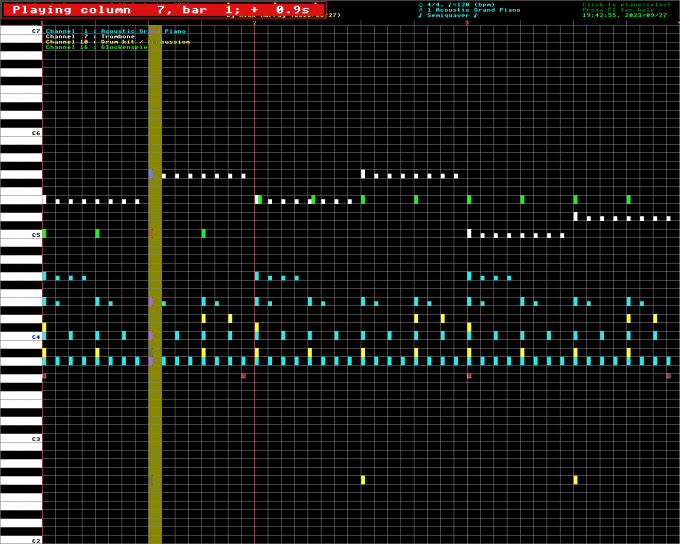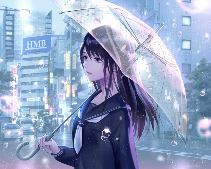Rick's b.log - entry 2023/10/01 |
| ||||||
mailto: blog -at- heyrick -dot- eu
You are not reading my b.log using HTTPS. You can switch to HTTPS by clicking here. SimpleSeq v0.10 SimpleSeq playing music. Let's begin the tenth month with release zero-ten of SimpleSeq. In this version, the following things have been done:
Here's the download: Download simpleseq_010.zip (108.54K)
For RISC OS 5 machines with MIDI
Scorchio!It got up to 26°C today. The average is ten degrees lower. It was also plenty warm yesterday, so I tackled the brambles again.
The dumb thumbnail picture is a nod to how all the mainstream videos have pictures of the people pulling dumb looking "reaction faces". It's not just MrBeast or a dozen influencers I've never heard of, Dr. Becky and Sabine Hossenfelder are getting in on the crazy-face action. And, yeah, 26°C isn't that hot, it's just unusual for this time of year. But a "meh" face is kind of boring.
It was a composite of a frame from the start of the video proper, and a photo of my holding an asian parasol that I quickly ran outside and took. I used the Background Eraser app to remove the background of the photo of me, and then spent a ten minutes putting the parasol back into the image. I then used the Polish photo tweaker app to merge the picture of me into the through-the-window shot, and paste in an emoji just because.
ChooseBD colour determinationTalking of how things are made, I thought I'd explain how ChooseBD works out what colour to use for the pinboard text.The secret is to look to see how big the JPEG is, and create a sprite that is a sixteenth of that size.
SYS "XJPEG_FileInfo", 1, f$ TO ,, owid%, ohei% wid% = owid% / 16 hei% = ohei% / 16 sz% = (wid% * hei% * 4) + 512 DIM spr% sz% spr%!0 = sz% spr%!8 = 16 SYS "OS_SpriteOp", ( 9 + 256), spr% SYS "OS_SpriteOp", (15 + 256), spr%, "wrkspc", 0, wid%, hei%, 1 + (6 << 27) + (90 << 14) + (90 << 1)
SpriteOp 9 creates the sprite area. As we know we're going to be using full RGB, we can work out the size by simply multiplying the pixels by four, then adding in 512 bytes to cover headers and such. More than we need, but better that than not enough. The next task is to switch to redirecting output to the sprite.
SYS "OS_SpriteOp", (62 + 256), spr%, "wrkspc" TO ,,,sasz% DIM save% sasz% SYS "OS_SpriteOp", (60 + 256), spr%, "wrkspc", save% TO , r1%, r2%, r3% Here, the save area size is read and then the sprite is redirected.
Next, if the scaling ratio is set to
DIM scl% 16 scl%!0 = wid% scl%!4 = hei% scl%!8 = owid% scl%!12= ohei% SYS "JPEG_PlotFileScaled", f$, 0, 0, scl%, 0 SYS "OS_SpriteOp", (60 + 256), r1%, r2%, r3% That final SpriteOp undoes the VDU redirection, so everything is normal now, and we have an image like this in memory:  A little version of a big image. It might seem small, but it's all we need.
Now, for speed, we're going to call Now, the original image is 3390×2714, or 9.2 million pixels. Our rescaled image is only 211×169, or 35,659 pixels. It's much smaller but it's enough to determine what we need. Here's the scanner: SYS "OS_SpriteOp", (24 + 256), spr%, "wrkspc" TO ,,addr%
red% = 0
green% = 0
blue% = 0
FOR yl% = 0 TO (hei% - 1)
FOR xl% = 0 TO (wid% - 1)
SYS &2E, (41 + 512), spr%, addr%, xl%, yl% TO ,,,,,col%
red% += ( col% AND 255)
green% += ( (col% >> 8) AND 255)
blue% += ( (col% >> 16) AND 255)
NEXT
NEXT
The first line gets us an address for the sprite, and the SYS &2E is the numerical way of calling OS_SpriteOp. What we're doing is simply whizzing through the image to see what colour every pixel is, and this (in the form &00BBGGRR) is split into red, green, and blue parts, which are cumulative. There's no need to worry about overflow as all pixels returning 255 adds up to only 9,093,045. A 32 bit value lets us count up to 4,294,967,295. Performing this calculation on the full size image would only add up to 2,346,117,300 so we don't have to worry about overshooting. For that image, our final results are 5,244,322 red, 5,809,786 green, and 6,906,236 blue.
val% = (red% / (wid% * hei%) ) OR
(green% / (wid% * hei%) ) OR
(blue% / (wid% * hei%) )
I've split this line C-like as it's long. What we're doing is dividing each of the red, green, and blue by the number of pixels to give us an average for each colour. Essentially we've converted the image to a value of 243 that represents the intensity of the image. It isn't a grey dot because we ORed the values, we didn't add them and divide by three for an average (that would be something like 168 off the top of my head). Then, if the intensity is over 140 we'll go with white on black, otherwise it's black on white. You could shave off a few centiseconds (to 2.6s) by rewriting the loop like this: R% = 0 : G% = 0 : B% = 0 H% = hei% - 1 : W% = wid% - 1 S% = spr% : A% = addr% FOR Y% = 0 TO H% : FOR X% = 0 TO W% SYS &2E,553,S%,A%,X%,Y% TO ,,,,,C% R%+=(C% AND 255) G%+=((C%>>8)AND255) B%+=((C%>>16)AND255) NEXT : NEXT And you could shave off nearly a second (2.1s) by ditching OS_SpriteOp completely and poking around the sprite memory. As we created a 16M colour sprite, we know the arrangement of each word.
R% = 0 : G% = 0 : B% = 0
E% = hei% * wid% * 4
O% = addr% + 40
FOR L% = 0 TO E% STEP 4
C% = O%!L%
R%+=(C% AND 255)
G%+=((C%>>8)AND255)
B%+=((C%>>16)AND255)
NEXT
However, this is one of the larger images. The rest are smaller so take less time, and using legal OS calls is better (in karmic sense) than directly poking around memory regions.
Your comments:Please note that while I check this page every so often, I am not able to control what users write; therefore I disclaim all liability for unpleasant and/or infringing and/or defamatory material. Undesired content will be removed as soon as it is noticed. By leaving a comment, you agree not to post material that is illegal or in bad taste, and you should be aware that the time and your IP address are both recorded, should it be necessary to find out who you are. Oh, and don't bother trying to inline HTML. I'm not that stupid! ☺ ADDING COMMENTS DOES NOT WORK IF READING TRANSLATED VERSIONS.
|
(Felicity? Marte? Find out!)
📺 The SIBA stories 📹
It's a simple substring match.
Last read at 06:10 on 2024/05/02.


| |||||||||||||||
| Next entry - 2023/10/03 Return to top of page |
| © 2023 Rick Murray |
| Retrieved from http://heyrick.eu/blog/index.php?diary=20231001 on 2nd May 2024 |


